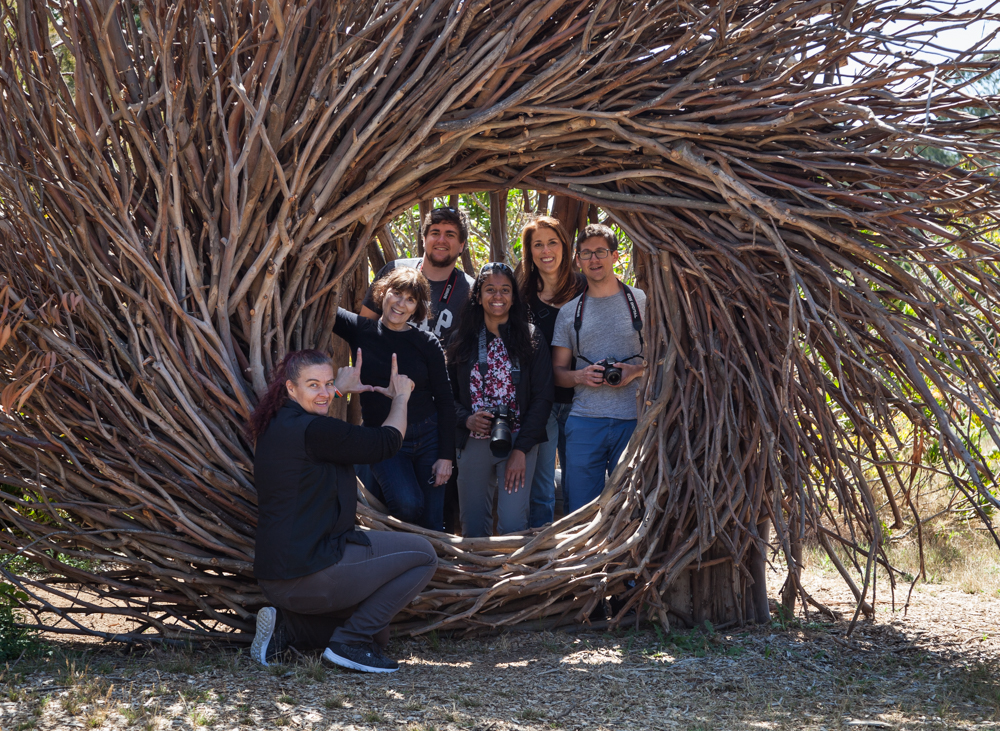
|
|
|||||
Here in the San Francisco Bay Area, we are lucky to have such a wide variety of spectacular scenery to choose from when deciding where and what to photograph next. In just a few hours drive (or less), we can be at the beach with its sparkling ocean, or in the mountains with its majestic peaks, or in a forest of spectacular redwood trees. But we also have some pretty amazing places right in our back yard, especially when looking to capture gorgeous flowers and plants.
One of the best places to see incredible variety of plant life is at the UC Santa Cruz Arboretum, near the coast in Santa Cruz, CA. The arboretum is a 135-acre research and teaching facility maintaining over 300 plant families, some of which are rare and threatened, from Australia, New Zealand, South Africa, and California. This rich diversity offers a unique opportunity for study, research, and of course, photography.
On a recent Saturday morning, I met 5 excited students to explore what the Arboretum had to offer, learn a little more about photography, and hopefully have a lot of fun. Everyone arrived right on time and was eager to get started.
 I start the workshop with some brief introductions to help me get to know my students and find out what their expectations are for the morning. After introductions were complete, I covered a few of the basic principles of photography that we would be practicing during our workshop. I reviewed the technical aspects of the Exposure Triangle and how Aperture, Shutter Speed, and ISO work together to create images. Next I covered some of the more creative aspects of photography and compositional basics like Rule of Thirds, Leading Lines, and awareness of your backgrounds and textures. Last, I highlighted some of the environmental challenges we would have to work with such as bright sun, slight breezes, and possible overcast skies.
I start the workshop with some brief introductions to help me get to know my students and find out what their expectations are for the morning. After introductions were complete, I covered a few of the basic principles of photography that we would be practicing during our workshop. I reviewed the technical aspects of the Exposure Triangle and how Aperture, Shutter Speed, and ISO work together to create images. Next I covered some of the more creative aspects of photography and compositional basics like Rule of Thirds, Leading Lines, and awareness of your backgrounds and textures. Last, I highlighted some of the environmental challenges we would have to work with such as bright sun, slight breezes, and possible overcast skies.
I answered a few quick questions, gave my students some basic settings for their cameras to start with, then we were off to explore! The Arboretum landscape constantly changes depending on the season so it is always different and interesting to find out what's currently in bloom. On this particular visit, we found that there was an exhibit featuring environmental art installations from local artist. We were definitely going to work those into our photos! We started in the Australian garden with Kangaroo Paw and its fuzzy blooms of red and yellow, moved through the New Zealand Garden, down into the South African garden and its alien-like Protea with its stunning colors. We continued through the California natives section, and ended up in the Aroma garden and the Succulents with their wide variety of textured and patterned plants.
 As we proceed through the arboretum, I let my students explore to uncover what they find interesting to photograph. I check in with each person to help them fine-tune compositions, explore different camera settings, reinforce some of the concepts we were learning about, and most importantly, make sure we were all having fun!! I challenged everyone to really look at the subject matter, try to see the different angles, move positions to create more interesting compositions, and appreciate the colors, textures, and the setting as a whole.
As we proceed through the arboretum, I let my students explore to uncover what they find interesting to photograph. I check in with each person to help them fine-tune compositions, explore different camera settings, reinforce some of the concepts we were learning about, and most importantly, make sure we were all having fun!! I challenged everyone to really look at the subject matter, try to see the different angles, move positions to create more interesting compositions, and appreciate the colors, textures, and the setting as a whole.
As we progressed I saw each of my students begin to get more and more comfortable with their cameras and the resulting images were truly satisfying. It was soon approaching the end of our time, and we set up for the group photo making sure to take advantage of a wonderful art installation. At our final stop in the Succulent garden, I answered a few final questions, gave a few more bits of information and encouraged everyone to continue practicing what they had learned today. Then I bid them all Adieu, and closed the book on another very successful Aperture Academy Workshop!
Until next time,
DeAnna and the rest of the Aperture Academy Team
P.S. If you'd like to join us at one of our workshops, you can find the schedule/sign up here.
 |
 |
 |
 |
 |
 |
 |
 |
 |
 |
 |
 |
 | |
|
 |
Other Cool Stuff→ Past Workshop Photos → 72dpi.com → How-To Articles → Photographer of the Month |
 |
Contact Us→ Contact Us → About Us → Site Map |
© 2009-2024 Aperture Academy, Inc.






